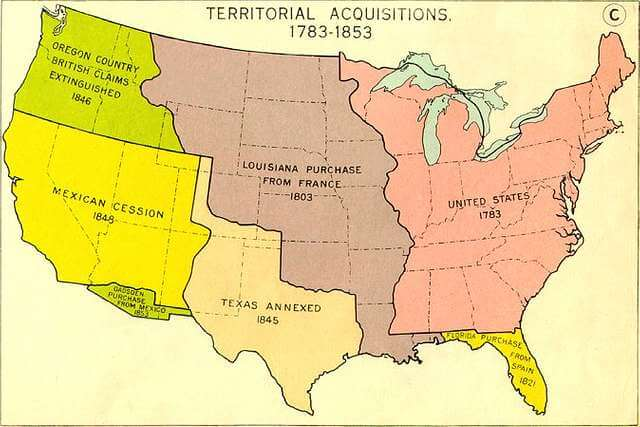How Did the Louisiana Purchase Affect the United States?
The so-called ‘Louisiana Purchase’ (Vente de la Louisiane in French) was the acquisition by the United States from the French in 1803 of 2,140,000 km² of territory then known as French Louisiana.

The so-called ‘Louisiana Purchase’ (Vente de la Louisiane in French) was the acquisition by the United States from the French in 1803 of 2,140,000 km² of territory then known as French Louisiana. This purchase doubled the size of the United States and extended its dominion over the entire Mississippi-Missouri basin to the border of the Rocky Mountains. The land acquired included the present-day states of Arkansas, Missouri, Iowa, Oklahoma, Kansas, Nebraska, part of Minnesota, most of North Dakota, South Dakota, the northeastern part of New Mexico, the northern end of Texas, part of Montana, Wyoming, the area east of Colorado and part of Louisiana, including the city of New Orleans. The far north also included part of the modern Canadian provinces of Alberta and Saskatchewan. The whole covered 23% of the current US borders. The Louisiana Purchase was a pivotal moment in Thomas Jefferson’s presidency, although it was initially the subject of internal opposition, with some supporters arguing that it was unconstitutional. Jefferson, however, believed that the US Constitution did not explicitly preclude such a transaction and that this was an opportunity to limit the influence of France and Spain, which had previously blocked access to the trade-critical port of New Orleans. The 1795 Treaty of Pinckney with Spain had allowed US merchants to use the port only to store goods, limiting their access. However, the Mississippi River, controlled by New Orleans, remained essential to western US trade. France, meanwhile, had gained a prominent role in North America following the Treaty of San Ildefonso, in which Napoleon returned Louisiana to French control. Jefferson wanted to complete the purchase of the New Orleans area and sent negotiators to Paris, including James Monroe and Robert R. Livingston, with the initial aim of securing access to the port of New Orleans alone. Negotiations were complicated and at first the French were reluctant to cede territory, which would have meant losing control of the Americas. The political situation in Europe was complex and Napoleon needed to concentrate his forces in the war against Britain.
Why France Sold The US The Louisiana Territory
In 1802-1803, a series of complicated situations arose between the French administration and the inhabitants of Saint-Domingue (now Haiti and Guadeloupe): rebellions by the local population led to the defeat of the French colonial troops and the consequent need to suppress the rebellion by force. Convinced of the difficulty of fighting on several fronts, Napoleon was determined to concentrate his forces on the situation in Europe. The decisive factor that led Bonaparte to abandon his American project and instead turn his attention to an invasion of the British Isles by arming a fleet of barges was the failure of the British to honour an agreement. The Treaty of Amiens stipulated that the British should evacuate the island of Malta by September 1802, which they failed to do. Having therefore abandoned plans for a French empire in America, on 10 April 1803 Napoleon informed François Barbé-Marbois, Minister of the Treasury, of his intention to cede Louisiana to the United States. However, a few days before Monroe’s arrival, Marquis Barbé-Marbois offered Livingston the whole of Louisiana. President Jefferson’s instructions to Livingston were to buy New Orleans alone, but Napoleon was confident that he would not refuse such an advantageous offer. The US negotiators were prepared to spend $10 million for New Orleans alone and were astonished when they were offered the whole of Louisiana for $15 million.
After The Sale
Almost all of the land was occupied by Native Americans, from whom the land was later bought piece by piece. The purpose of the sale was therefore not the actual ownership of the land, but the possibility of owning it at a later date. However, none of the contracting parties consulted the natives, who were the real owners of the land, and they probably did not even know about the treaty. The treaty was signed in Paris on 30 April 1803 by Robert Livingston, James Monroe and the Marquis Barbé-Marbois. Jefferson announced the treaty on 4 July, after which Livingston uttered the famous phrase: “We have lived long, but this has been the noblest work of all our lives”. The Senate ratified the treaty on 20 October and the next day authorized President Jefferson to take possession of the territory and establish a provisional military government. On 31 October, it also decreed that the civil organization of the place should temporarily maintain the lines imposed by the previous Spanish and French rule, and authorized the president to use the army to maintain order. Regarding the mapping of the western lands, a mission was organized to explore the new territories, later known as the Lewis and Clark expedition.
Conclusion
The Louisiana Purchase not only greatly expanded the territory of the United States, but also consolidated control over the Mississippi River and opened the door to the development of the American West, proving to be a political and strategic move of great importance to the national interests of the United States.
